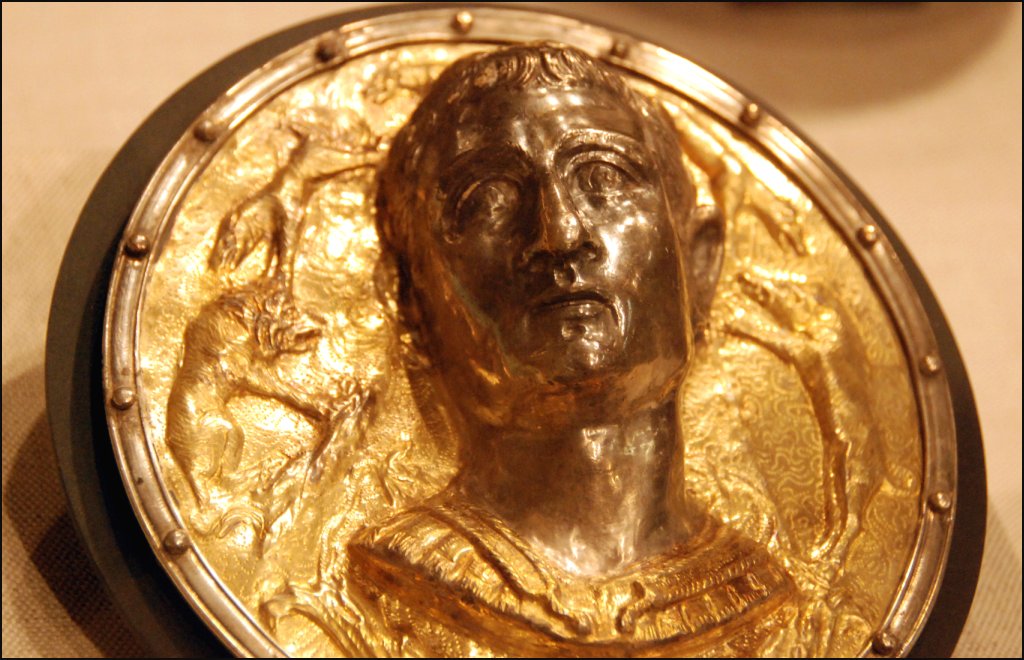Sculptural Relief
Examples of sculptural relief on ancient coins. Pictures courtesy of Forvm members.
Lysimachus Tetradrachm by Dominicus:

Plautius Plancus Medusa Denarius by Dominicus:

Faustina II Aureus by Frederic Weber:


Helios Trihemidrachm by Congius:


Athens by dougsmit:

Rhodes by dougsmit:

Aigina by dougsmit:

Thessaly Larissa drachm by Dominicus:


Roman coins by berserkrro:



Alexander Jannaeus prutah by goldenancients

Ptolemy IV Tetradrachm by mihali84:

Vesta seated on the
reverse of a
Caligula As...by goldenancients:

Seleucos I Tetradrachm by maridvnvm:

Caracalla Denarius by goldenancients:

Hercules with the Nemean lion on a greek coin by Minos:

Lysimachus Tetradrachm by mihali84:

Athens Tetradrachm by Jay GT4:

Roman Republic denarius by crawforde:

Shield portrait of Roman Emperor Augustus.
Sheet silver worked in repoussť to form the high relief portrait , engraved, partly gilded.
About 15-30 A.D.
Weight: 220 grams.
The Toledo Museum of Art- USA.
The Romans called this type of portrait ina round frame a shield (imago clipeata).
It represents the first emperor, Caesar Augustus (born 63 B.C.).
The heir of Julias Caesar was only 18 years old when Caesar was assassinated in 44 B.C.. Thanks to polical savvy. charisma, and luck, Augustus brought an end to cival war, and peace to people around the Mediterranean Sea.
The acanthus leaves under the bust mean he is deceased.
Augustus died in 14 A.D.and was promply defied by the Senate.
Augustus wears a laurel wreath and armor. On the background three dogs hunt a lion and a boar. These symbols of war and hunting represent Augustus' s militairy might.
The animals are drawn with stippled, curving lines not common in classical Greek or Roman art but typical of art made along the northeastern frontier of the Empire.
This suggests that this costly portrait was made as a diplomatic gift for a local ruler, to remind him of the power and majesty of Rome. (from Flickr associate Hans Ollermann)
Joe Geranio - Julio Claudian Iconographic Association

VERY RARE for JULIO CLAUDIAN PRINCEPS- Claudius 41-54 A.D.
Joe Geranio- Julio Claudian Iconographic Association
Private Sale
Princeps Claudius Imago clipeata
This is very rare to find a Julio Claudian Princeps on something other than coinage or in the round. This radiate portrait of Claudius quite rare and shows the Princeps as Pontifex Maximus (see items flanked rt. and left) simpuvium and littus. Claudius ruled from 41-54 A.D.
Artist or Maker:
CIRCA MID TO LATE 1ST CENTURY A.D.
Title:
A ROMAN BRONZE IMAGO CLIPEATA OF THE EMPEROR CLAUDIUS
Description:
CIRCA MID TO LATE 1ST CENTURY A.D.
Of hammered sheet, sculpted in high relief within the concave tondo, the Emperor depicted wearing a radiate crown, with a full cap of short comma-shaped locks of hair, a single hooked lock before each prominent ear, with a broad cranium and tapering chin, his face with emphatic signs of aging in the two furrows of the forehead and bags under his wide eyes, the pupils articulated, the brows modelled, the rounded nose with pronounced naso-labial folds, the small mouth with full lips, the neck creased, wearing a toga with V-shaped folds at the neck and a pallium over the shoulders, the bust flanked by the symbols of the office of pontifex maximus, a dipper (simpuvium) to the left and a wand (lituus) to the right, framed by a raised band of Lesbian kymation off set by beading, the edges folded over a lead backing
9 3/4 in. (24.7 cm.) diameter
Provenance:
Found at the Roman settlement of Derventio, near Stamford Bridge, Yorkshire, England in 1991.
The Property of a Gentleman; Christie's, London, 8 July 1992, lot 168.
The Property of a Gentleman; Christie's, London, 5 July 1995, lot 197.
with Royal-Athena Galleries, New York, 1996 (Art of the Ancient World, 1997, no. 53).
Notes:
THE STAMFORD BRIDGE TONDO
PROPERTY FROM A NEW YORK PRIVATE COLLECTION
Tiberius Claudius Nero Germanicus was born in Lyon, France (ancient Lugdunum) in 10 B.C. He was the youngest son of Drusus and Antonia the Younger (the niece of Augustus and daughter of Marc Antony). Due to poor health and a pronounced stammer, his family assumed that he would never achieve success. According to Suetonius (Lives of the Caesars: Claudius, III,2), even his own mother considered him "a monster, a man whom Mother Nature had begun to work upon but then flung aside." He was not granted any major position during the reigns of Augustus or Tiberius, but in 37 A.D., during the reign of his nephew Caligula, he shared the consulate and presided at the public games in the Emperor's absence. Claudius was possibly involved in the plot to assassinate Caligula, and he succeeded his nephew at the age of 51 as the fourth Emperor of Rome on 24 January 41 A.D. (see Kleiner, Roman Sculpture, pp. 129-134 and Varner, ed., From Caligula to Constantine: Tyranny & Transformation in Roman Portraiture, p. 114).
In 43 A.D. Claudius ordered the invasion of Britain by a force of 40,000 soldiers. Following the successful campaign, Camulodunum (Colchester) was made the capital. After his murder in 54 A.D., Claudius was deified by a decree of the Senate under Nero. A temple was begun at Camulodunum in his honor, but was destroyed during the Boudican revolt of 60 A.D. Another was completed in Rome by Vespasian.
The presence of the radiate crown worn by Claudius on the Stamford Bridge Tondo suggests that, like the temples dedicated in his honor, this portrait was a posthumous creation, as Claudius's successor Nero was the first Roman emperor represented wearing such a crown during his lifetime (see Varner, op. cit., p. 128). The discovery of the Stamford Bridge Tondo in Yorkshire attests to Claudius's popularity in Britain. Its original function is unknown.
For another imago clipeata of Claudius now in the Louvre see p. 166 in Massner, "Zum Stilwandel im Kaiserportršt claudisher Zeit" in Die Regierungszeit des Kaisers Claudius (41-54 n. Chr.).



















